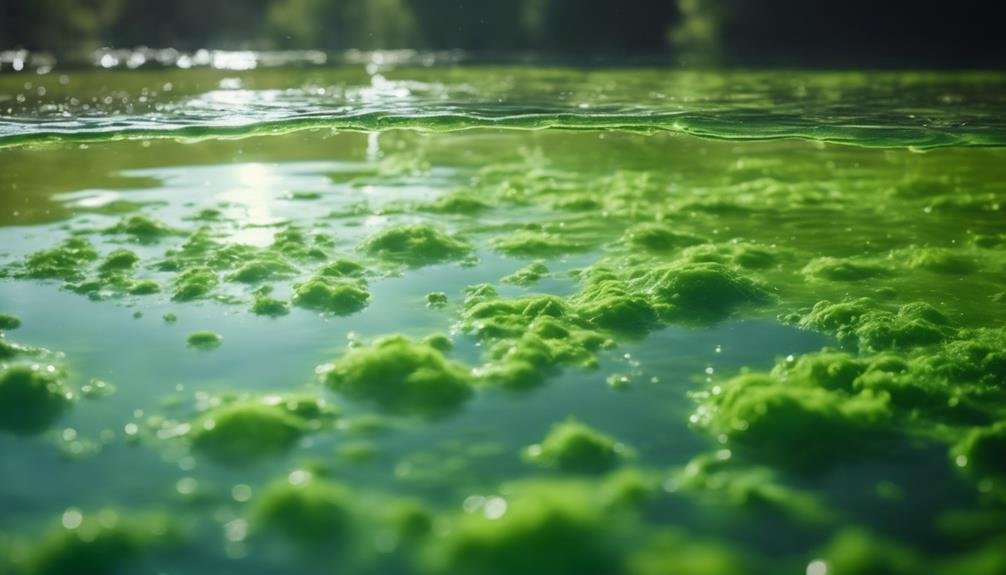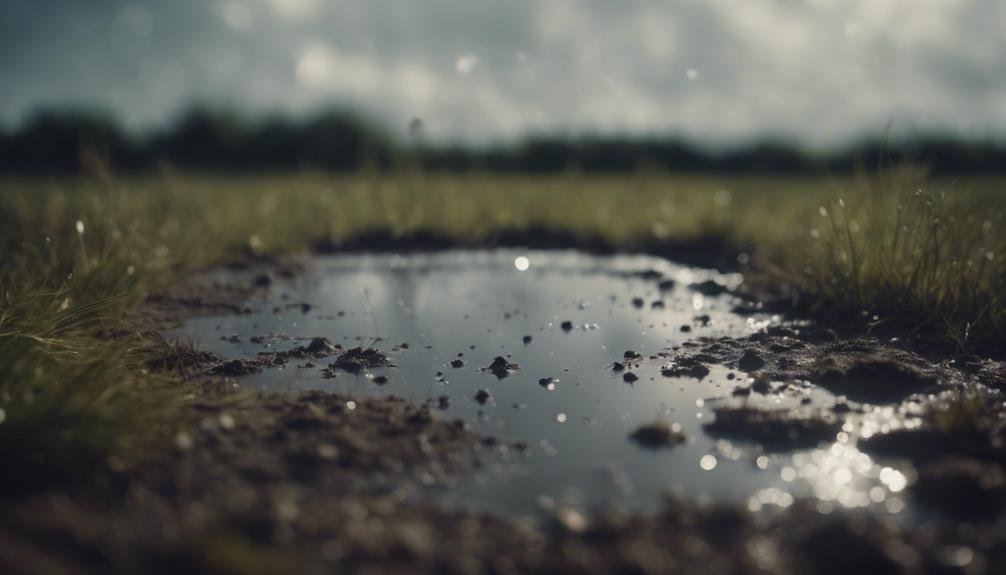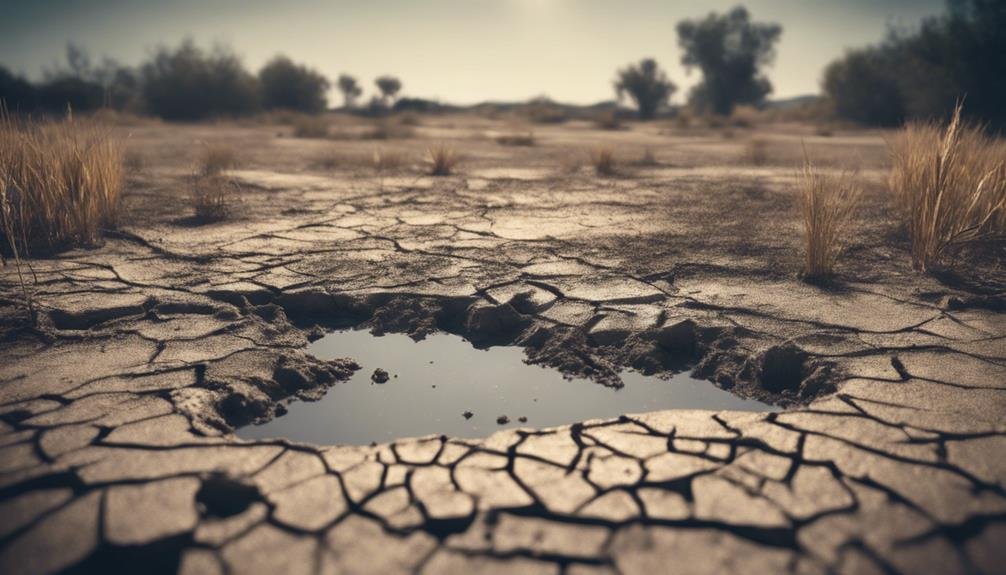We should keep an eye out for any noticeable decrease in water levels, whether gradual or sudden, as this could be a sign of a leak. If we notice muddy areas or saturated soil around the pond's edge, it's likely that there is seepage happening.
Changes in water quality, such as an increase in algae growth or fish appearing distressed at the surface, can also indicate a potential leak. Sinkholes forming near the pond may point to structural issues that need to be addressed.
A sudden decrease in water clarity, resulting in murky water, could be caused by sediment being stirred up due to a crack or hole in the pond. If we find ourselves needing to refill the pond more often than usual, this could be a sign of an underlying leak that needs to be investigated.
By delving deeper into the issue, we can learn how to accurately identify and resolve any seepage problems.
Declining Water Levels
A noticeable indication of a potential pond leak is a gradual decrease in water levels without a logical explanation such as evaporation or drainage. If you observe your pond losing water more quickly than usual, even without extreme heat or dry weather, a leak could be the culprit. It's crucial to monitor the water level closely and keep a record of any changes over time. If the decline persists without a clear reason, it's likely that there's a leak somewhere in the pond's structure or lining.
Another sign to look out for is damp or soggy areas around the pond, indicating that water is escaping. Take time to inspect the edges of the pond for any cracks, holes, or other possible sources of leakage. Additionally, check the inlet and outlet pipes for any signs of damage or inadequate sealing.
If there's suspicion of a leak, it's vital to address it promptly to prevent further water loss and potential harm to the surrounding environment. Seeking guidance from a pond professional can help pinpoint the issue and determine the most effective repair solutions.
Muddy Spots Nearby
Today, we're diving into the topic of muddy spots near your pond, a sign that there might be a leak to address. Pay close attention to areas of saturated soil surrounding your pond, especially if you notice the water level dropping.
Unusual wet patches next to the pond could also indicate a breach that's allowing water to escape. These muddy spots serve as important clues that shouldn't be ignored, as they can help you pinpoint the source of the leak and take prompt action to prevent further water loss.
Don't hesitate to investigate any suspicious areas and consider using leak detection products like dye testers or pond sealants to remedy the situation before it worsens. Remember, addressing pond leaks early can save you time, money, and potential damage to your pond ecosystem.
Saturated Soil Area
One common indicator of a pond leak is the presence of saturated soil or muddy areas nearby. These wet spots tend to develop outside the pond's perimeter and gradually spread over time. The saturation occurs as water escapes from the pond and saturates the surrounding soil. As the moisture content increases, the soil loses its ability to absorb more water, resulting in the formation of puddles and mud on the surface.
To detect this issue, it's essential to inspect the area surrounding the pond after a period of dry weather. If you notice any damp or muddy patches, it could signify a leak that's allowing water to seep out. The size and location of these saturated areas can offer insights into the source and extent of the leak.
For example, a large concentrated muddy area may indicate a significant breach, while scattered smaller patches could suggest multiple minor leaks or cracks. By closely monitoring these saturated soil spots, you can identify problems early on and address them to prevent further damage.
Sinking Pond Level
When the water level in a pond starts to drop and muddy spots appear nearby, it's a clear sign of a leak that needs investigating. A sinking water level indicates that the pond is losing water, with areas along the edges becoming exposed and muddy as a result. This muddy ring is a key indicator of water escaping from the pond, along with the visible decrease in depth compared to previous water levels.
The speed at which the water level is dropping can give us an idea of how severe the leak is – a rapid drop suggests a significant breach. To determine the rate of water loss, we can conduct a simple leak test by marking the water level and checking it again after 24-48 hours. This will help us quantify the extent of the issue.
Once we confirm the leak, it's essential to carefully inspect the entire perimeter of the pond for signs such as saturated soil, erosion, or other clues that could pinpoint the source of the leak. By taking these steps, we can identify and address the problem before it escalates.
Adjacent Wet Spots
When inspecting the area around a leaking pond, it's crucial to carefully look for muddy or saturated spots that indicate seepage. These wet areas, commonly located near the pond's edges, offer valuable clues about water movement underground and potential leak sites.
If you come across a single wet spot, it may point to a small leak in that specific area, prompting you to mark it for further investigation. On the other hand, finding multiple wet spots in a line could suggest a crack or trench leak. In such cases, it's important to trace the line and mark the endpoints to understand the extent of the issue.
Moreover, a large saturated area is a red flag for a major leak or a drainage problem that needs immediate attention. By prioritizing these areas for repair, you can prevent further damage to the pond and surrounding environment.
Algae Bloom Intensification

A pond leak can often be identified by an increase in algae blooms. When water is lost from the pond, it can disrupt the balance of nutrients, leading to an overabundance of fertilizers that stimulate the growth of algae.
This excess nutrient supply fuels photosynthesis, causing algae to multiply rapidly. This process can disrupt the natural ecosystem of the pond and harm aquatic life.
It's crucial to address pond leaks promptly to prevent further imbalances and maintain a healthy environment for plants and animals.
Overfertilization Causes
Overfertilization is often underestimated, but it significantly worsens algal blooms, a clear sign of pond contamination. Understanding the main culprits behind overfertilization is crucial for tackling these unsightly and potentially harmful blooms.
The excessive presence of nutrients, particularly nitrogen and phosphorus, serves as a growth stimulant for algae, leading to their rapid proliferation and forming dense colonies. These nutrients can have diverse origins, as outlined in the table below:
| Source | Nitrogen | Phosphorus |
|---|---|---|
| Fertilizers | ✅ | ✅ |
| Animal Waste | ✅ | ✅ |
| Decaying Organic Matter | ✅ | ✅ |
| Soil Erosion | ✅ |
Runoff from lawns, gardens, and agricultural areas carries fertilizers into the pond, creating a surplus of nutrients. Moreover, animal waste and decomposing plant material directly release nutrients into the water. To prevent overfertilization, it is essential to manage these nutrient sources effectively and maintain a harmonious balance within the pond ecosystem.
Nutrient Imbalance Symptoms
When ponds are overfertilized, it can lead to the unsightly and potentially harmful growth of algal blooms, indicating a nutrient imbalance. Some signs to watch out for include the water turning pea-green, the accumulation of thick mats of stringy algae along the edges, unpleasant odors from decomposing organic matter, and fish struggling to breathe or appearing lethargic due to low oxygen levels.
These symptoms point to an excess of nutrients like nitrogen and phosphorus, which fuel the rapid growth of algae. As the algae die off, their decomposition consumes oxygen, leading to oxygen depletion that can harm aquatic life.
Sudden algae blooms can quickly deteriorate water quality, making the pond less habitable. It's crucial to address the root cause by reducing fertilizer use and properly managing the pond ecosystem.
If left unchecked, the nutrient imbalance will continue to promote algal overgrowth, negatively impacting the pond's health and appearance.
Photosynthesis Acceleration Effects
When a leaking pond experiences an increase in nutrient levels, algae cells respond by accelerating their photosynthetic activity to take advantage of the abundance. This boost in photosynthesis results in a rapid growth of algae populations, forming thick, unattractive blooms that can give the water a green or reddish-brown appearance.
The heightened rate of photosynthesis also causes changes in the pond's chemistry. As algae photosynthesize, they absorb excess carbon dioxide, which in turn raises the water's pH levels. This pH spike often coincides with the intensified bloom.
Furthermore, the proliferation of algae leads to an overproduction of oxygen as a byproduct of photosynthesis. Excessively high oxygen levels can be harmful to fish and other aquatic organisms. By monitoring these chemical changes along with the noticeable color changes in the water, we can identify nutrient overload from a leak as the probable cause of the issue.
Fish Gasping at Surface
One clear sign of a pond leak is when fish start gasping for air at the water's surface. This behavior, called 'piping,' indicates that the oxygen levels in the water have dropped to dangerous levels. As the leak causes the pond to lose water, there's less water available to absorb oxygen from the air, putting stress on the aquatic life.
Signs to watch out for include fish repeatedly coming up to the surface, gasping for air, clustering near water inlets or aeration systems, showing signs of sluggishness, or struggling to stay afloat. If dead or dying fish start floating on the surface, immediate action is crucial to prevent further losses.
To address the issue, it's important to inspect the pond for cracks, damaged liners, or other possible sources of leakage. In the meantime, temporarily adding an aeration system or water agitator can help boost oxygen levels until the leak is identified and fixed. Keeping an eye on the fish's behavior can serve as an early warning system, enabling proactive steps to protect the pond's ecosystem.
Mysterious Sinkholes Forming

Sinkholes can appear unexpectedly on the pond's surface or banks, indicating a possible leak that needs immediate investigation. These sinkholes are a sign of potential structural issues with the pond, often formed when water erodes the soil beneath the pond's liner or clay base. This erosion can be caused by leaks, excessive groundwater flow, or even burrowing animals.
When we spot sinkholes, it's crucial to assess their size and location. Smaller sinkholes near the pond's edge may be simpler to fix, while larger ones in the center could signify a more significant problem.
To address this, we must carefully drain the pond, identify the source of the leak or erosion, and repair or replace the affected areas. This process can be intricate, so seeking guidance from a professional pond contractor or engineer is advisable to ensure the repairs are done correctly and prevent future issues.
Sudden Loss of Clarity
When the water in your pond suddenly becomes murky, it might be a sign of a hidden leak. This cloudiness is often noticeable after heavy rain or prolonged dry spells. The murky water could be due to soil erosion, decaying organic matter, algal blooms, or groundwater seepage.
If the murkiness persists and isn't linked to these common causes, it could indicate a leak in the pond. Water escaping through cracks or holes can disrupt the pond's bottom, stirring up sediment and reducing visibility. To investigate further, carefully inspect the pond's banks and liner for any signs of damage or seepage.
If the water level is dropping along with the loss of clarity, it strongly suggests a leak that requires immediate attention to prevent further water loss and potential structural problems.
Compulsory Refilling Frequency

If you find yourself constantly refilling your pond with water, it could be a sign of a leak. Keeping an eye on how quickly your pond loses water and how often you need to top it up is crucial. A gradual drop in water level that requires frequent refilling is a clear indicator that something might be amiss.
To give you an idea of the correlation between water loss and refilling frequency, here's a breakdown: if you notice a slight leak, you might need to top up your pond on a monthly basis. However, if the leak is more significant, you might find yourself refilling weekly, daily, or even multiple times a day for severe leaks.
It's important to monitor your pond closely to catch any leaks early on. Detecting and addressing the issue promptly can prevent further water loss and potential harm to the pond ecosystem.
Surrounding Vegetation Changes
Noticing changes in the plants around a pond can signal a potential leak. When water escapes, it can create wet spots around the pond, affecting plant life. Signs of a leak may include:
- Sudden growth of lush green grass or weeds in previously dry areas.
- Development of moss or algae near the pond's edge.
- Wilting or dying of certain plants due to too much or too little water.
- Emergence of new plants that thrive in wet conditions, like cattails or rushes.
These subtle changes can escalate with time, indicating a leak.
Monitoring unusual growth patterns or plant changes is crucial. If these signs are present, it may indicate water loss, necessitating further investigation or repairs.
Conclusion
It's crucial to stay vigilant when it comes to pond leaks as they can quickly escalate into environmental disasters, disrupting fragile ecosystems.
Acting promptly upon noticing any irregularities is essential. Seeking advice from experts to identify the root cause and applying effective solutions is necessary to prevent further complications.
Neglecting the issue can lead to more expensive and intricate fixes down the line. Proactive maintenance plays a vital role in safeguarding our beloved aquatic environments for future generations to enjoy.

